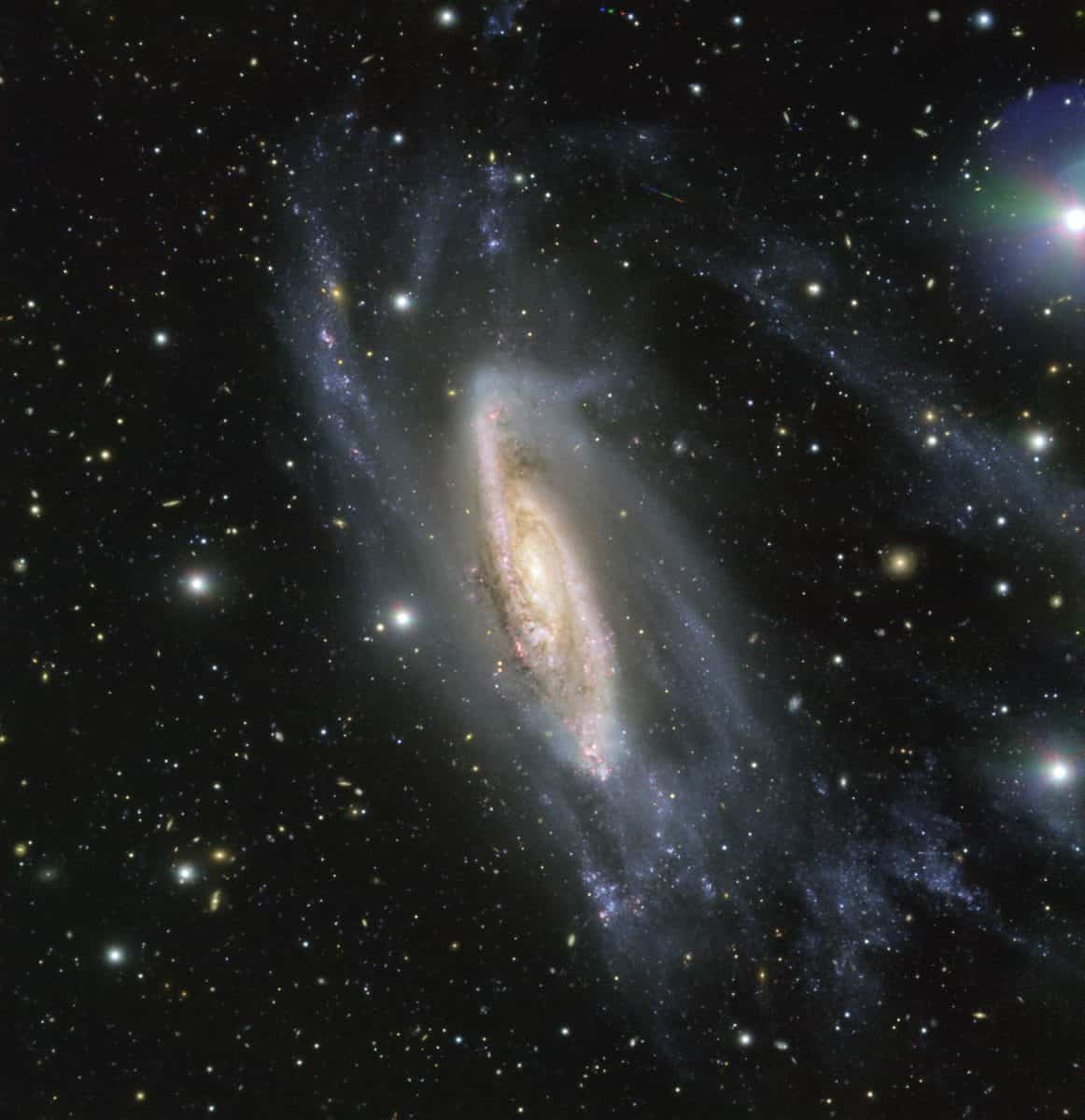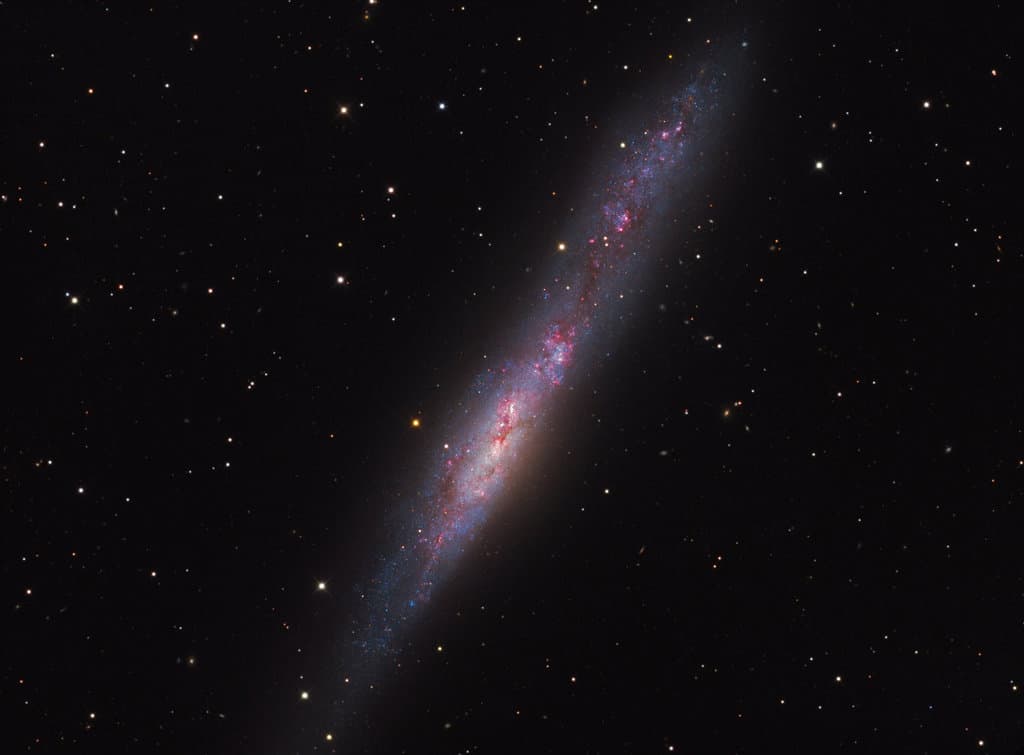Blog
NGC 3981 is a spiral galaxy located 62 million light-years away in the constellation of Crater. It was discovered on February 7, 1785 by William Herschel.
NGC 3981 is a member of the NGC 4038 Group which is part of the Virgo Supercluster.
more...Theodore “Fats” Navarro (September 24, 1923 – July 7, 1950 was an American jazz trumpet player. He was a pioneer of the bebop style of jazz improvisation in the 1940s. He had a strong stylistic influence on many other players, including Clifford Brown.
Navarro was born in Key West, Florida, of Cuban, African, and Chinese descent. He began playing piano at age six, but did not become serious about music until he began playing trumpet at the age of thirteen. He was a childhood friend of drummer Al Dreares. By the time he graduated from Douglass High School, he wanted to be away from Key West and joined a dance band headed for the Midwest.
Tiring of the road life after touring with many bands and gaining valuable experience, including influencing a young J. J. Johnson when they were together in Snookum Russell‘s territory band, Navarro settled in New York City in 1946, where his career took off. He met and played with, among others, Charlie Parker, one of the greatest musical innovators of modern jazz improvisation.[citation needed] But Navarro was in a position to demand a high salary and did not join one of Parker’s regular groups. He also developed a heroin addiction, tuberculosis, and a weight problem (he was nicknamed “Fat Girl”). These afflictions led to a slow decline in his health and death at the age of twenty-six. Navarro was hospitalized on July 1 and died in the evening of July 6, 1950. His last performance was with Charlie Parker on July 1 at Birdland.
Navarro played in the Andy Kirk, Billy Eckstine, Benny Goodman, and Lionel Hampton big bands, and participated in small group recording sessions with Kenny Clarke, Tadd Dameron, Eddie “Lockjaw” Davis, Coleman Hawkins, Illinois Jacquet, Howard McGhee, and Bud Powell.
more...Lemon Henry “Blind Lemon” Jefferson (September 24, 1893 – December 19, 1929) was an American blues and gospel singer, songwriter, and musician. He was one of the most popular blues singers of the 1920s and has been called the “Father of the Texas Blues“.
Jefferson’s performances were distinctive because of his high-pitched voice and the originality of his guitar playing. His recordings sold well, but he was not a strong influence on younger blues singers of his generation, who could not imitate him as easily as they could other commercially successful artists. Later blues and rock and roll musicians, however, did attempt to imitate both his songs and his musical style.
Jefferson was born blind (or possibly partially blind), near Coutchman, Texas. He was the youngest of seven (or possibly eight) children born to Alex and Clarissa Jefferson, who were African-American sharecroppers. Disputes regarding the date of his birth derive from contradictory census records and draft registration records. By 1900, the family was farming southeast of Streetman, Texas. Jefferson’s birth date was recorded as September 1893 in the 1900 census. The 1910 census, taken in May, before his birthday, confirms his year of birth as 1893 and indicated that the family was farming northwest of Wortham, near his birthplace.
more...Born in Bulgaria and now living in London, her talent has brought rapturous comments (“exquisite” – San Diego Union-Tribune) for the purity and range of her music. Inspired by the traditional music of her homeland, in 2005 Eugenia formed the Perunika Trio, an a cappella group that’s not only delved deep into Bulgarian music, but also old songs from Macedonia, Russia and other Slavic countries.
more...Messier 63 (M63) is a spiral galaxy located in the constellation Canes Venatici, the Hunting Dogs.
It has an apparent visual magnitude of 8.5 and is approximately 29.5 million light-years distant from the Sun.
Also cataloged as NGC 5055, Messier 63 is around 100,000 light-years across, about the size of our Milky Way Galaxy.
Discovered by French astronomer Pierre Mechain in June 1779, the galaxy later made it as the 63rd entry into Charles Messier’s famous catalogue, published in 1781.
It is a member of the M51 Group – a group of galaxies, named after its brightest member, Messier 51 (Whirlpool Galaxy).
The galaxy has faint, extended features that could be the result of gravitational interactions with nearby galaxies.
It shines across the electromagnetic spectrum and is thought to have undergone bursts of intense star formation.
On May 25, 1971, a Type I supernova (SN 1971I) was detected in Messier 63, peaking at magnitude 11.8.
Distance 27 Mly
more...
John William Coltrane (September 23, 1926 – July 17, 1967 Hamlet, NC) was an American jazz saxophonist and composer, also known as “Trane“. Working in the bebop and hard bop idioms early in his career, Coltrane helped pioneer the use of modes and was later at the forefront of free jazz. He led at least fifty recording sessions, and appeared on many albums by other musicians, including trumpeter Miles Davis and pianist Thelonious Monk.
Over the course of his career, Coltrane’s music took on an increasingly spiritual dimension. Coltrane remains one of the most influential saxophonists in music history. He received many posthumous awards and recognitions, including canonization by the African Orthodox Church and a special Pulitzer Prize in 2007. His second wife was pianist Alice Coltrane and their son, Ravi Coltrane, is also a saxophonist.
In the summer of 1955, Coltrane was freelancing in Philadelphia while studying with guitarist Dennis Sandole when he received a call from Davis. The trumpeter, whose success during the late forties had been followed by several years of decline in activity and reputation, due in part to his struggles with heroin, was again active and about to form a quintet. Coltrane was with this edition of the Davis band (known as the “First Great Quintet”—along with Red Garland on piano, Paul Chambers on bass, and Philly Joe Jones on drums) from October 1955 to April 1957 (with a few absences). During this period Davis released several influential recordings that revealed the first signs of Coltrane’s growing ability. This quintet, represented by two marathon recording sessions for Prestige in 1956, resulted in the albums Cookin,’ Relaxin’, Workin’, and Steamin’. The “First Great Quintet” disbanded due in part to Coltrane’s heroin addiction.
At the end of this period Coltrane recorded his first album as leader for Atlantic Records, Giant Steps (1959), which contained only his compositions. The album’s title track is generally considered to have one of the most difficult chord progressions of any widely played jazz composition. Giant Steps utilizes Coltrane changes. His development of these altered chord progression cycles led to further experimentation with improvised melody and harmony that he continued throughout his career.
Coltrane formed his first quartet for live performances in 1960 for an appearance at the Jazz Gallery in New York City. After moving through different personnel including Steve Kuhn, Pete La Roca, and Billy Higgins, the lineup stabilized in the fall with pianist McCoy Tyner, bassist Steve Davis, and drummer Elvin Jones. Tyner, from Philadelphia, had been a friend of Coltrane’s for some years and the two men had an understanding that the pianist would join Coltrane when Tyner felt ready for the exposure of regularly working with him. Also recorded in the same sessions[clarification needed] were the later released albums Coltrane’s Sound (1964) and Coltrane Plays the Blues (1962).
with Jimmy Garrison, Elvin Jones and McCoy Tyner
more...Ray Charles Robinson (September 23, 1930 – June 10, 2004 Albany, GA), known professionally as Ray Charles, was an American singer-songwriter, musician, and composer. Among friends and fellow musicians he preferred being called “Brother Ray”. He was often referred to as “The Genius”.Charles was blind from the age of seven.
He pioneered the soul music genre during the 1950s by combining blues, rhythm and blues, and gospel styles into the music he recorded for Atlantic Records. He also contributed to the integration of country music, rhythm and blues, and pop music during the 1960s with his crossover success on ABC Records, most notably with his two Modern Sounds albums. While he was with ABC, Charles became one of the first black musicians to be granted artistic control by a mainstream record company.
Charles cited Nat King Cole as a primary influence, but his music was also influenced by country, jazz, blues, and rhythm and blues artists of the day, including Louis Jordan and Charles Brown. He became friends with Quincy Jones. Their friendship lasted until the end of Charles’s life. Frank Sinatra called Ray Charles “the only true genius in show business”, although Charles downplayed this notion.
In 2002, Rolling Stone ranked Charles number ten on its list of the “100 Greatest Artists of All Time“, and number two on their November 2008 list of the “100 Greatest Singers of All Time”. Billy Joel observed, “This may sound like sacrilege, but I think Ray Charles was more important than Elvis Presley”
more...Morrocan Gnawa master
more...The Tarantula Nebula (also known as 30 Doradus) is an H II region in the Large Magellanic Cloud (LMC).
The Tarantula Nebula was observed by Nicolas-Louis de Lacaille during an expedition to the Cape of Good Hope between 1751 and 1753. He catalogued it as the second of the “Nebulae of the First Class”, “Nebulosities not accompanied by any star visible in the telescope of two feet”. It was described as a diffuse nebula 20′ across.
Johann Bode included the Tarantula in his 1801 Uranographia star atlas and listed it in the accompanying Allgemeine Beschreibung und Nachweisung der Gestirne catalogue as number 30 in the constellation “Xiphias or Dorado”. Instead of being given a stellar magnitude, it was noted to be nebulous.
The name Tarantula Nebula arose the mid 20th century from the appearance in deep photographic exposures.
30 Doradus has often been treated as the designation of a star, or of the central star cluster NGC 2070, but is now generally treated as referring to the whole nebula area of the Tarantula Nebula.
The Tarantula Nebula has an apparent magnitude of 8. Considering its distance of about 49 kpc (160,000 light-years), this is an extremely luminous non-stellar object. Its luminosity is so great that if it were as close to Earth as the Orion Nebula, the Tarantula Nebula would cast visible shadows. In fact it is the most active starburst region known in the Local Group of galaxies. It is also one of the largest such regions in the Local Group with an estimated diameter of 200 pc. The nebula resides on the leading edge of the LMC where ram pressure stripping, and the compression of the interstellar medium likely resulting from this, is at a maximum.
more...Bobby Radcliff, born Robert Radcliff Ewan, is an American blues guitarist, singer, songwriter and painter. Radcliff, raised in Bethesda, Maryland, began playing guitar at the early age of 12, attending a variety of concerts that would come through the area (Blues, Bluegrass, Rockabilly, Country, Rock, Jazz, etc.). Radcliff played in a number of bands beginning at age 13, as both a guitarist and vocalist.
He is known for his position in the band “The Yarbs” (bandleader Chris Pestalozzi) which played cover songs, standards, and originals, crossing many genres, with an emphasis on original compositions and Blues. In 1968, Radcliff also joined “The Northside Blues Band”, alongside Brett Littlehales (harmonica), Guy Dorsey (keyboard), William Bowman (bass), and Van Holmead (drums).
more...Fletcher Smith (born September 22, 1913 in Lincoln , Nebraska , August 15, 1993 in Los Angeles ) was an American rhythm & blues – and jazz pianist .
Fletcher Smith played for Cootie Williams in 1943 and in the following years with Slim Gaillard , King Perry , Varetta Dillard , Jimmy Rushing , Big Maybelle , Linda Hopkins , Sister Rosetta Tharpe , Earl Bostic , Stick McGhee , Mickey Baker , Percy Mayfield , King Perry and Geechie Smith . Under his own name ( Fletcher Smith’s Squares, Fletcher Smiths band ) he played in the 1950s several singles such as Mean Poor Gal , Ting Ting Boom Scat or Shout, Shout, Shout . In the field of jazz he was involved between 1943 and 1959 in 36 recording sessions.
more...Muslim Niger
more...Irregular galaxy NGC 55 is thought to be similar to the Large Magellanic Cloud (LMC). But while the LMC is about 180,000 light-years away and is a well known satellite of our own Milky Way Galaxy, NGC 55 is more like 6 million light-years distant and is a member of the Sculptor Galaxy Group. Classified as an irregular galaxy, in deep exposures the LMC itself resembles a barred disk galaxy. Spanning about 50,000 light-years, NGC 55 is seen nearly edge-on though, presenting a flattened, narrow profile in contrast with our face-on view of the LMC. Just as large star forming regions create emission nebulae in the LMC, NGC 55 is also seen to be producing new stars. This highly detailed galaxy portrait highlights a bright core crossed with dust clouds, telltale pinkish star forming regions, and young blue star clusters in NGC 55.
more...Leonard Norman Cohen CC GOQ (September 21, 1934 – November 7, 2016) was a Canadian singer-songwriter, poet and novelist. His work explored religion, politics, isolation, sexuality and personal relationships. Cohen was inducted into the Canadian Music Hall of Fame, the Canadian Songwriters Hall of Fame, and the Rock and Roll Hall of Fame. He was invested as a Companion of the Order of Canada, the nation’s highest civilian honour. In 2011, Cohen received one of the Prince of Asturias Awards for literature and the ninth Glenn Gould Prize.
Cohen pursued a career as a poet and novelist during the 1950s and early 1960s; he did not launch a music career until 1967, at the age of 33. His first album, Songs of Leonard Cohen (1967), was followed by three more albums of folk music: Songs from a Room (1969), Songs of Love and Hate(1971) and New Skin for the Old Ceremony (1974). His 1977 record Death of a Ladies’ Man was co-written and produced by Phil Spector, which was a move away from Cohen’s previous minimalist sound. In 1979, Cohen returned with the more traditional Recent Songs, which blended his acoustic style with jazz and Oriental and Mediterranean influences. Perhaps Cohen’s most famous song, “Hallelujah” was first released on his studio album Various Positions in 1984. I’m Your Man in 1988 marked Cohen’s turn to synthesized productions and remains his most popular album. In 1992, Cohen released its follow-up, The Future, which had dark lyrics and references to political and social unrest.
Cohen returned to music in 2001 with the release of Ten New Songs, which was a major hit in Canada and Europe. His eleventh album, Dear Heather, followed in 2004. Following a successful string of tours between 2008 and 2013, Cohen released three albums in the final four years of his life: Old Ideas (2012), Popular Problems (2014) and You Want It Darker (2016), the last of which was released three weeks before his death.
more...Foreststorn “Chico” Hamilton, (September 20, 1921 – November 25, 2013) was an American jazz drummer and bandleader.
He came to prominence as sideman with the likes of Lester Young, Gerry Mulligan, Count Basie and Lena Horne. Hamilton then struck out as a bandleader, first with a quintet featuring the cello as a lead instrument, an unusual choice for a jazz band in the 1950s, and subsequently leading a number of groups over the years that performed cool jazz, post bop and jazz fusion.
Foreststorn Hamilton was born in Los Angeles, California, one of three brothers. Another brother was actor Bernie Hamilton.
Hamilton started his career in a band with Charles Mingus, Illinois Jacquet, Ernie Royal, Dexter Gordon, Buddy Collette and Jack Kelso before he had finished high school. Engagements with Lionel Hampton, Slim & Slam, T-Bone Walker, Lester Young, Count Basie, Duke Ellington, Charlie Barnet, Billy Eckstine, Nat King Cole, Sammy Davis Jr., Billie Holiday, Gerry Mulligan and Lena Horne established his career.
Hamilton appeared in You’ll Never Get Rich (1941) as part of the backing group supporting Fred Astaire. Hamilton also performed on the soundtrack of the Bing Crosby and Bob Hope film Road to Bali (1952).
more...Charles Thomas “Tommy” Potter (September 21, 1918 – March 1, 1988) was a jazz double bass player, best known for having been a member of Charlie Parker‘s “classic quintet”, with Miles Davis, between 1947 and 1950.
Born in Philadelphia, Potter had first played with Parker in 1944, in Billy Eckstine‘s band with Dizzy Gillespie, Lucky Thompson and Art Blakey.[1]
Potter also performed and recorded with many other notable jazz musicians, including Earl Hines, Artie Shaw, Bud Powell, Count Basie, Sonny Rollins, Stan Getz, Max Roach, Eddie Heywood, Tyree Glenn, Harry “Sweets” Edison, Buck Clayton and Charles Lloyd.
more...More Posts
- Nothando Zulu doesn’t separate the artist from the community
- Chris Johnson: He Gets Paid by the Rest
- Johnna Morrow: Survival Through Diversification
- Kevin Washington: Jumping Out of the Box
- Milo Fine: Composing in Real Time
- Homewood Studios: You Do Not Have to Leave the Community to Find Great Art
- David Harris: Music Builds Community
- Jamie Carter: Music is a Reflection of Life
- Merlin Brunkow-Bronco Keeps on Playing
- Scott Nieman-Music Brings People Together Locally and Globally
- KARIBUNI
- Maqam
- Ancestor Energy
- Maroons
- Mojo Roots
- Voices of Sepharad
- Beau Koo Jacks
- World Cafe International
- Mojo Roots: Prakriti’s Kiss
- Ancestor Energy: Allwhere




